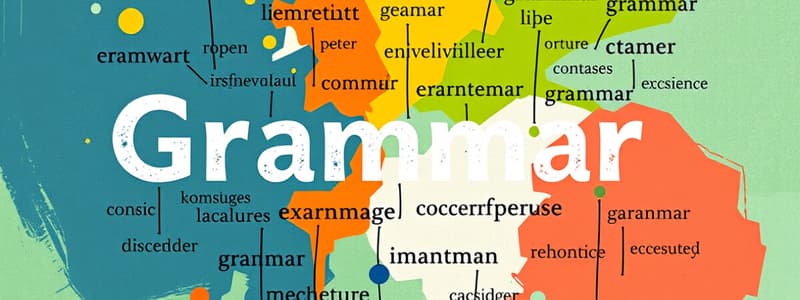Podcast
Questions and Answers
Which part of speech indicates relationships in time and space?
Which part of speech indicates relationships in time and space?
- Prepositions (correct)
- Adverbs
- Nouns
- Adjectives
What is a key characteristic of the Romanticism literary movement?
What is a key characteristic of the Romanticism literary movement?
- Emphasis on emotion and nature (correct)
- Focus on everyday life and society
- Emphasis on logic and reason
- Adoption of traditional forms
Which sentence structure consists of one independent clause and one or more dependent clauses?
Which sentence structure consists of one independent clause and one or more dependent clauses?
- Simple
- Compound
- Compound-complex
- Complex (correct)
Which type of writing aims to convince the reader?
Which type of writing aims to convince the reader?
Which of the following is a common feature of English phonetics and phonology?
Which of the following is a common feature of English phonetics and phonology?
What does the term 'borrowing' refer to in vocabulary?
What does the term 'borrowing' refer to in vocabulary?
Which global regions primarily speak English as a first language?
Which global regions primarily speak English as a first language?
What is the process of learning a language through exposure known as?
What is the process of learning a language through exposure known as?
Study Notes
Overview of English
- Language Family: Germanic branch of the Indo-European language family.
- Global Reach: Widely spoken as a first language in countries like the USA, UK, Canada, Australia, and New Zealand; important second language worldwide.
Phonetics and Phonology
- Vowels: Distinction between short and long vowels, diphthongs.
- Consonants: Voiced and voiceless sounds, place and manner of articulation.
- Stress and Intonation: Importance of syllable stress in words and intonation patterns in sentences.
Grammar
-
Parts of Speech:
- Nouns: Common, proper, abstract, collective.
- Verbs: Action, linking, auxiliary.
- Adjectives: Descriptive, comparative, superlative.
- Adverbs: Manner, place, time, frequency, degree.
- Pronouns: Personal, possessive, reflexive, relative.
- Prepositions: Indicate relationships in time and space.
-
Sentence Structure:
- Simple: Subject + Verb + Object.
- Compound: Two independent clauses joined by a conjunction.
- Complex: One independent clause and one or more dependent clauses.
Vocabulary
-
Word Formation:
- Derivation: Adding prefixes and suffixes.
- Compounding: Combining two or more words.
- Borrowing: Adopting words from other languages.
-
Idioms and Phrasal Verbs: Common expressions and verbs that change meaning when combined with prepositions or adverbs.
Writing
-
Styles:
- Descriptive: Evokes sensory experience.
- Narrative: Tells a story with a clear sequence.
- Persuasive: Aims to convince the reader.
- Expository: Informs or explains a topic.
-
Structure:
- Introduction: Presents the main idea.
- Body: Develops the argument or narrative.
- Conclusion: Summarizes and reflects on the topic.
Literature
- Genres: Fiction, non-fiction, poetry, drama, and essays.
- Key Movements:
- Romanticism: Emphasis on emotion and nature.
- Realism: Focus on everyday life and society.
- Modernism: Breaks from traditional forms and explores new techniques.
Dialects and Variations
- British vs. American English: Differences in spelling, vocabulary, pronunciation.
- Regional Dialects: Variations in language use based on geographic areas.
Language Learning
- Acquisition: Natural process of learning a language through exposure.
- Learning: Formal instruction and practice in language skills.
- Skills: Reading, writing, listening, speaking.
Cultural Impact
- Influence on Other Languages: English as a lingua franca; impact of English on global communication, media, and technology.
- Cultural Identities: English as a means of expressing cultural identity and heritage.
Overview of English
- Germanic branch of the Indo-European language family.
- First language of millions in the USA, UK, Canada, Australia, and New Zealand; significant as a second language globally.
Phonetics and Phonology
- Vowel distinctions include short and long vowels, as well as diphthongs.
- Consonants categorize into voiced and voiceless sounds, differentiated by place and manner of articulation.
- Syllable stress in words and the use of intonation patterns in sentences play crucial roles in pronunciation.
Grammar
- Parts of Speech:
- Nouns can be common, proper, abstract, or collective.
- Verbs are categorized as action, linking, or auxiliary.
- Adjectives include descriptive, comparative, and superlative forms.
- Adverbs express manner, place, time, frequency, or degree.
- Pronouns include personal, possessive, reflexive, and relative types.
- Prepositions indicate relationships related to time and space.
- Sentence Structure:
- Simple sentences follow the Subject + Verb + Object format.
- Compound sentences combine two independent clauses with conjunctions.
- Complex sentences feature one independent clause and one or more dependent clauses.
Vocabulary
- Word Formation:
- Derivation involves adding prefixes and suffixes to create new words.
- Compounding combines two or more words into a new term.
- Borrowing entails adopting words from other languages.
- Idioms and Phrasal Verbs: Highlight the nuanced meanings of common expressions and the alterations in meaning when verbs combine with prepositions or adverbs.
Writing
- Styles:
- Descriptive writing evokes sensory experiences.
- Narrative writing unfolds a story with a specific sequence.
- Persuasive writing seeks to convince the audience.
- Expository writing aims to inform or explain topics clearly.
- Structure:
- Introductions present the main idea.
- Body sections develop arguments or narratives.
- Conclusions summarize the content and offer reflections.
Literature
- Literary genres include fiction, non-fiction, poetry, drama, and essays.
- Key Movements:
- Romanticism prioritizes emotion and nature.
- Realism centers on everyday life and societal issues.
- Modernism deviates from classical forms, exploring innovative techniques.
Dialects and Variations
- Distinct differences exist between British and American English in aspects like spelling, vocabulary, and pronunciation.
- Regional dialects exhibit linguistic variations influenced by geographic locations.
Language Learning
- Language acquisition occurs naturally through exposure to the language.
- Formal language learning involves structured instruction and practice across diverse skills.
- Essential skills encompass reading, writing, listening, and speaking.
Cultural Impact
- English serves as a lingua franca, significantly affecting global communication, media, and technology.
- The language acts as a vehicle for expressing cultural identity and heritage, shaping personal and communal narratives.
Studying That Suits You
Use AI to generate personalized quizzes and flashcards to suit your learning preferences.
Description
This quiz covers the essential aspects of the English language, including its phonetics, phonology, grammar, and parts of speech. Explore the distinctions between various vowel and consonant sounds, as well as the intricacies of English sentence structure. Perfect for language learners and enthusiasts alike.




